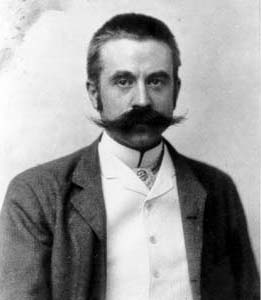Stanford White
Stanford White (November 9, 1853 – June 25, 1906) was an American architect who became one of the most prominent designers in the United States during the Gilded Age, with his works exemplifying the Beaux-Arts architectural style. White was a partner in the architectural firm of McKim, Mead & White, one of the most significant American architectural firms at the turn of the twentieth century.
Early Life and Education[edit | edit source]
Stanford White was born in New York City to Richard Grant White, a noted Shakespearean scholar, and Alexina Black Mease. He was exposed to the arts and architecture at an early age, which influenced his career path. White did not receive a formal architectural education but learned his craft through apprenticeships and extensive travel in Europe, a common practice among his contemporaries in the field of architecture.
Career[edit | edit source]
In 1879, White joined forces with Charles Follen McKim and William Rutherford Mead to form McKim, Mead & White, a firm that would go on to design some of the most iconic buildings in America. The firm's work included commercial buildings, private residences, and public institutions, characterized by their grandeur and adherence to classical forms.
Some of Stanford White's most notable projects include:
- The Washington Square Arch in New York City, a triumphal arch built to commemorate the centennial of George Washington's inauguration as President of the United States.
- The New York Herald Building, an early skyscraper that was demolished in 1921.
- The Breakers, a Vanderbilt mansion in Newport, Rhode Island, epitomizing the opulence of the Gilded Age.
- The original Pennsylvania Station in New York City, a monumental train station that was controversially demolished in 1963.
Personal Life and Legacy[edit | edit source]
Stanford White's personal life was marked by his extravagant lifestyle and involvement in several high-profile scandals, the most notorious being his relationship with actress Evelyn Nesbit, which led to his murder by her husband, Harry Kendall Thaw, in what was dubbed the "Trial of the Century."
Despite his personal controversies, White's architectural legacy is significant. His designs have left a lasting impact on American architecture, influencing the development of the Beaux-Arts style in the United States. His work is celebrated for its beauty, innovation, and the way it reflected the aspirations of the United States during a period of rapid economic and cultural growth.
Death[edit | edit source]
Stanford White was shot and killed by Harry Kendall Thaw at the rooftop theater of Madison Square Garden, a building he himself had designed, on June 25, 1906. His death was sensationalized by the media, overshadowing his professional achievements for a time.
Conclusion[edit | edit source]
Stanford White's contributions to American architecture are undeniable. His work with McKim, Mead & White helped to define the architectural landscape of the Gilded Age, and his buildings continue to be admired for their design and historical significance.
This article is a architecture-related stub. You can help WikiMD by expanding it!
Search WikiMD
Ad.Tired of being Overweight? Try W8MD's physician weight loss program.
Semaglutide (Ozempic / Wegovy and Tirzepatide (Mounjaro / Zepbound) available.
Advertise on WikiMD
|
WikiMD's Wellness Encyclopedia |
| Let Food Be Thy Medicine Medicine Thy Food - Hippocrates |
Translate this page: - East Asian
中文,
日本,
한국어,
South Asian
हिन्दी,
தமிழ்,
తెలుగు,
Urdu,
ಕನ್ನಡ,
Southeast Asian
Indonesian,
Vietnamese,
Thai,
မြန်မာဘာသာ,
বাংলা
European
español,
Deutsch,
français,
Greek,
português do Brasil,
polski,
română,
русский,
Nederlands,
norsk,
svenska,
suomi,
Italian
Middle Eastern & African
عربى,
Turkish,
Persian,
Hebrew,
Afrikaans,
isiZulu,
Kiswahili,
Other
Bulgarian,
Hungarian,
Czech,
Swedish,
മലയാളം,
मराठी,
ਪੰਜਾਬੀ,
ગુજરાતી,
Portuguese,
Ukrainian
Medical Disclaimer: WikiMD is not a substitute for professional medical advice. The information on WikiMD is provided as an information resource only, may be incorrect, outdated or misleading, and is not to be used or relied on for any diagnostic or treatment purposes. Please consult your health care provider before making any healthcare decisions or for guidance about a specific medical condition. WikiMD expressly disclaims responsibility, and shall have no liability, for any damages, loss, injury, or liability whatsoever suffered as a result of your reliance on the information contained in this site. By visiting this site you agree to the foregoing terms and conditions, which may from time to time be changed or supplemented by WikiMD. If you do not agree to the foregoing terms and conditions, you should not enter or use this site. See full disclaimer.
Credits:Most images are courtesy of Wikimedia commons, and templates, categories Wikipedia, licensed under CC BY SA or similar.
Contributors: Prab R. Tumpati, MD





